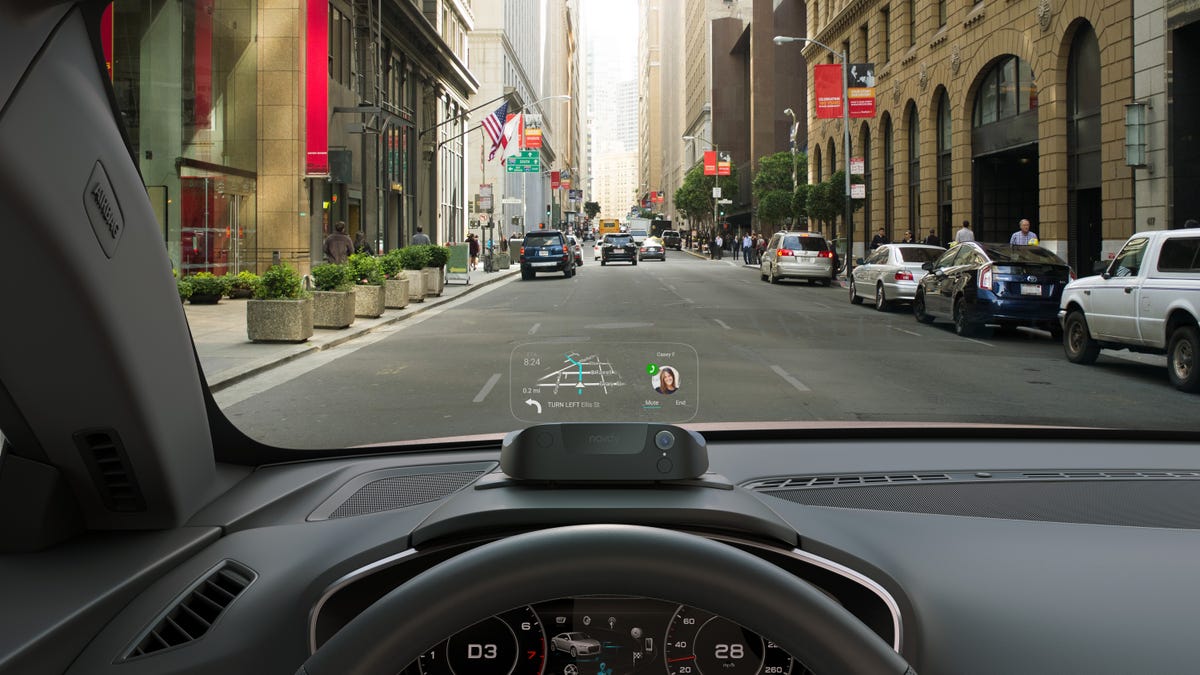Navdy begins shipping HUD-based automotive infotainment system
The Navdy head-up display projects bright, clear graphics in a driver's eye-line, showing navigation, vehicle speed and communications.

With a brighter, more crisp projection than that found built in to even luxury cars, the Navdy head-up display (HUD) begins with a clear, visual advantage. But add the fact that its capabilities go beyond the combined infotainment and HUD capabilities in most cars, and Navdy looks like a sure win.
Looking at a production unit, and seeing its HUD projection over a pre-recorded demo drive at Navdy's headquarters in San Francisco, I found myself wishing the Navdy product could be included as a standard feature in cars rather than as aftermarket equipment.
Navdy surfaced two years ago, showing off a very early example of its HUD technology and announcing a crowd-funding campaign to get the company off the ground. The campaign was a huge success, raising $6.7 million based on preorders of the Navdy unit at $299 each. At the time, Navdy said the production version would cost $499.
Those preorderers should count themselves very lucky now, as the company has begun shipping its Navdy HUD production units -- and offering new ones at a retail price of $799.
The Navdy unit is a combination head-up display and infotainment system, also integrating with smartphones.
The increased price represents more development of the Navdy HUD, going beyond what the company promised in 2014. The main unit sits on a dashboard, projecting its graphics onto a clear shield residing in the lower part of the driver's eye-line. A quick eye movement down lets the driver see vehicle speed, navigation instructions, alerts for incoming phone calls and text messages, audio information and vehicle gauges.
Navdy integrates with a driver's smartphone, using it as a source for music, contacts and communications, through the Navdy app, which is available for iOS and Android. Navigation is more of a hybrid function between the hardware and smartphone.
While the Navdy app relies on the Google Map app for route guidance and destination searches, the Navdy unit contains its own automotive grade GPS chip and antenna, giving it a more accurate location than a smartphone's GPS. Likewise, the Navdy unit includes an accelerometer, and plugs into the car's OBDII port, so it can read vehicle speed and use dead reckoning to figure out the car's location when it loses the GPS signal. To make navigation even more useful, the unit contains its own map database, provided by Here, as back-up for when it is out of cell tower range.
During a demo, I was particularly impressed with how Navdy makes its maps translucent, so they can project in front of the driver without blocking the view of the road. Every built-in HUD I've used in a car merely shows turn-by-turn directions, forcing me to look down at the dashboard LCD if I want an overview of the route.
In addition, the OBDII plug-in lets Navdy project the car's speed and fuel level. Given the navigation, fuel and speed projection, drivers would never really need to look at their cars' instrument clusters.
The Navdy unit incorporates some smarts. If the car is running low on gas, it will show an alert and offer the driver navigation to a nearby gas station. When under route guidance, the gas station will be as close to the programmed route as possible. Likewise, the Navdy app can integrate calendar information, alerting drivers to upcoming appointments and offering to navigate to meeting locations.
Navdy's interface does a spectacular job of switching between screens, for example splitting the display between navigation and an incoming call alert.
Navdy tested under different light conditions to make sure the projection remains at optimal visibility.
Doug Simpson, Navdy's CEO, says the the company put a lot of work into that interface over the last two years, and suggested that it may find use beyond an automotive HUD. The interface gives a "glimpse into how computing may look one day." Depending on future hardware, the Navdy interface might work for smart glasses or transparent computing screens.
While Navdy talked up using gesture control when it first surfaced, the production unit only supports simple hand waves to accept or reject phone alerts. During testing it found people did not want more complex gestures. To compensate, Navdy includes a Bluetooth-connected dial that straps to the car's steering wheel. The dial lets the driver scroll through menus, choose contacts for phone calls and other control functions.
Expanding control options, Navdy integrates with Siri and Google Assistant, so drivers can use voice to request music, search for destinations and place calls.
With its main projection unit, dial and OBDII connector, setting up Navdy in a car looks complex, but it really shouldn't be too difficult for anyone who knows a little about their car. However, Navdy has partnered with Enjoy, a company that sends out specialists to help people set up new devices. If opted, an Enjoy representative will come out and install the Navdy components in a car, then explain all the features.
As to my with that Navdy could be offered as built-in equipment in a car, Simpson says the company is in talks with automotive manufacturers, but has no partnerships to announce.

